Accepted Scientific Name: Aichryson tortuosum (Aiton) Webb & Berthel.
Hist. Nat. Iles Canaries (Phytogr.). 2(1): 184 1840. Webb & Berthel.
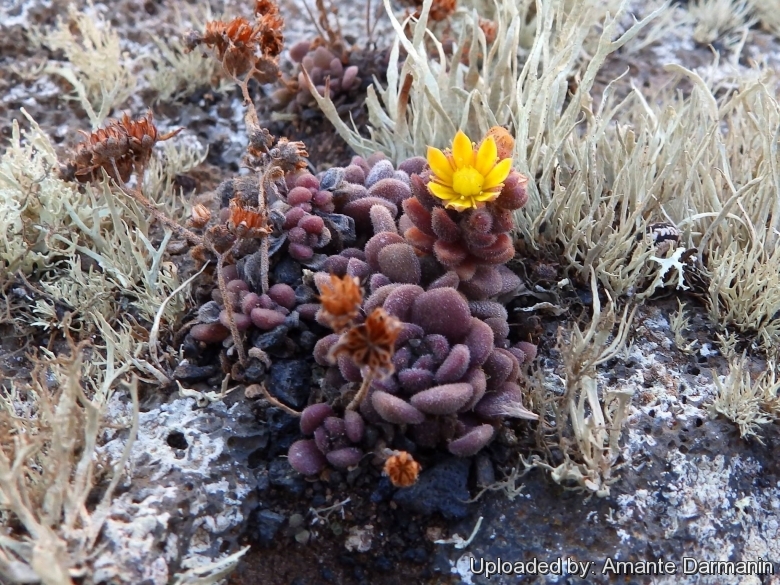
Aeonium tortuosum (Aichryson tortuosum) Photo by: Amante Darmanin
Blooming habit at Mirador del Rio, Lanzarote.
Origin and Habitat: Aichryson tortuosumSN|33680]]SN|33680]] is indigenous to the Canary Islands (Lanzarote and Fuerteventura), Spain.
Altitude range: Up to 700 metres above sea level.
Habitat and ecology: This species is confined to the arid regions of Lanzarote and Fuerteventura, which are the two driest of the Canary Islands. It grows tucked into crevices on the vertical sides of permanently windswept volcanic cliffs and at many places along the island shaded, northern ridges.
Synonyms:
See all synonyms of Aichryson tortuosum
back
Accepted name in llifle Database:Aichryson tortuosum (Aiton) Webb & Berthel.Hist. Nat. Iles Canaries (Phytogr.). 2(1): 184 1840.Synonymy: 11
Accepted name in llifle Database:Aichryson tortuosum subs. bethencourtianum (Bolle) BañaresWilldenowia 45(3): 454. 2015 [23 Nov 2015] [epublished]Synonymy: 4
back
Common Names include:
ENGLISH: gouty houseleek
Description: Often misspelled (tortulosum), Aichryson tortuosumSN|33680]]SN|33680]] is a small, very ornamental, perennial shrublet 10-15(-20) cm tall with dense tortuous branches, hence the specific name. It has crowded, fleshy and pubescent (downy) leaves in dense rosettes looking like a miniature Aeonium lindleyiSN|34938]]SN|34938]]. The small yellow flowers in a lax inflorescence typically have seven or eight petals. This neat little plant is the old and long-known Sempervivum tortuosumSN|33682]]SN|33682]]. It is quite variable and, as for most members of Aichryson, the true, unhybridized species is rarely seen in cultivation.
Stems: c. 5 mm thick, hairy, often glabrous below, Branches woody, tortuous, divaricate.
Leaves: Highly succulent, 10-12 long, 4-6 mm wide, 2-3 mm thick, blade broadest above the middle, obovate, rounded, sessile, densely glandular-hairy, viscid (scent resinous), dark green, tinged purplish-red or brown.
Inflorescence: From short laxly leafy shoots, few-flowered; Pedicels to 7 mm.
Flowers: 7- to 8-merous, 9 - 12 mm in diameter. Sepals glandular hairy (hairs up to 0.5 mm). Petals 5 - 6 mm, elliptic, acuminate, aristate, deep yellow, tips reflexed, margins often finely ciliate.
Seeds: Dust like.
Related species: Aichryson bethencourtianumSN|33680]]SN|33692]] Bolle is very similar to Aichryson tortuosumSN|33692]]SN|33680]], so similar that an expert in this genus as Bañares Baudet (2008) considers it to be, a subspecies the latter (Aichryson tortuosumSN|33680]]SN|33680]] ssp. bethencourtianum (Bolle) Bañares & S. Scholz). They are distinguished from each other primarily by the excretion of a viscid substance from the dense hairs of A. tortuosum, which has sessile leaves, as opposed to A. tortuosum ssp. bethencourtianum, which has indistinctly petiolate leaves and longer, non-glandular hairs. They occur sympatrically on Fuerteventura, but only A. tortuosum has reported occurrences on Lanzarote.
Subspecies, varieties, forms and cultivars of plants belonging to the group
 Aichryson tortuosum (Aiton) Webb & Berthel.: (subsp. tortuosum) has sessile leaves with short glandular hairs excreting a viscid substance. Distribution: Fuerteventura and Lanzarote, Canary Islands, Spain.
Aichryson tortuosum (Aiton) Webb & Berthel.: (subsp. tortuosum) has sessile leaves with short glandular hairs excreting a viscid substance. Distribution: Fuerteventura and Lanzarote, Canary Islands, Spain.- Aichryson tortuosum subs. bethencourtianum (Bolle) Bañares: has indistinctly petiolate leaves and longer, non-glandular hairs. Distribution: Fuerteventura, Canary Islands, Spain.
Bibliography: Major references and further lectures
1) Urs Eggli “Illustrated Handbook of Succulent Plants: Crassulaceae: Crassulaceae” Springer Science & Business Media, 2003
2) Gideon Smith, Ben-Erik Van Wyk “The Garden Succulents Primer” Timber Press, 2008
3) Ray Stephenson “An unusual epiphytic succulent: Aichryson tortuosum!” Cactus and Succulent Journal 84(5):247-249. 2012 URL: http://dx.doi.org/10.2985/0007-9367-84.5.247
4) Massimo Afferni “The genus Aichryson” 102 - XEROPHILIA • Volume IV, No. 4 (15), December 2015 | ISSN 2285-3987
5) T. Ryan O'Leary “Phylogenetics and biogeography of Aichryson inferred from chloroplast DNA sequences” Thesis URL: https://kuscholarworks.ku.edu/bitstream/handle/1808/5584/OLeary_ku_0099M_10466_DATA_1.pdf?sequence=1
6) Bañares Baudet, Á., Marrero Gómez, M. V. & Scholz, S.: “Taxonomic and nomenclatural notes on Crassulaceae of the Canary Islands, Spain.” – Willdenowia 38: 475-489. – ISSN 0511-9618; © 2008 BGBM Berlin-Dahlem. doi:10.3372/wi.38.38208 (available via http://dx.doi.org/)
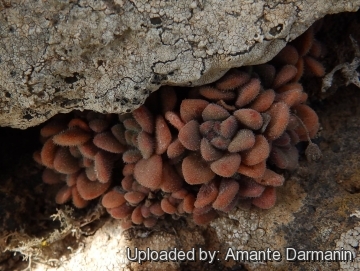 Aichryson tortuosum var. tortuosum, Mirador del Bosequicillo, Lanzarote. (Aichryson tortuosum) Photo by: Amante Darmanin
Aichryson tortuosum var. tortuosum, Mirador del Bosequicillo, Lanzarote. (Aichryson tortuosum) Photo by: Amante Darmanin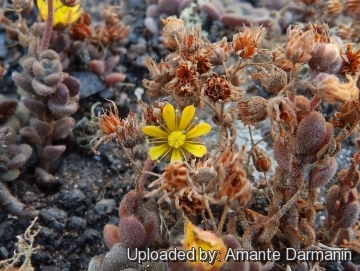 Aichryson tortuosum var. tortuosum, Mirador del Rio, Lanzarote. (Aichryson tortuosum) Photo by: Amante Darmanin
Aichryson tortuosum var. tortuosum, Mirador del Rio, Lanzarote. (Aichryson tortuosum) Photo by: Amante Darmanin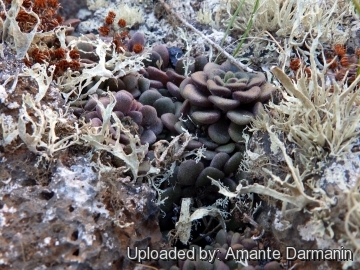 Aichryson tortuosum var. tortuosum, Mirador del Rio, Lanzarote. (Aichryson tortuosum) Photo by: Amante Darmanin
Aichryson tortuosum var. tortuosum, Mirador del Rio, Lanzarote. (Aichryson tortuosum) Photo by: Amante Darmanin Growing habit at Mirador del Rio, Lanzarote (Aichryson tortuosum) Photo by: Amante Darmanin
Growing habit at Mirador del Rio, Lanzarote (Aichryson tortuosum) Photo by: Amante Darmanin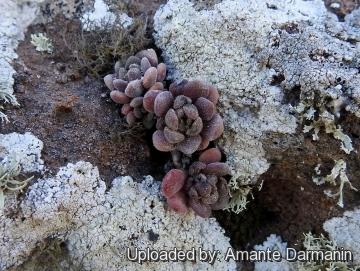 Aichryson tortuosum var. tortuosum, Eremita de las nieves, Lanzarote. (Aichryson tortuosum) Photo by: Amante Darmanin
Aichryson tortuosum var. tortuosum, Eremita de las nieves, Lanzarote. (Aichryson tortuosum) Photo by: Amante DarmaninSend a photo of this plant.The gallery now contains thousands of pictures, however it is possible to do even more. We are, of course, seeking photos of species not yet shown in the gallery but not only that, we are also looking for better pictures than those already present.
Read More... Cultivation and Propagation: Aichryson tortuosumSN|33680]]SN|33680]] is a most delightful miniature winter growing succulent that tend to go dormant in the summer and look a little tired sometimes, but they perk up again in the fall. Summer is the natural dormant season for this species in its native land. However, don't let the plants go dry for any extended time. Suitable for indoor culture it can be grown in shade, but needs sun to bring out full colour.
Soil: It requires gritty well drained potting mix.
Water requirements: Water deeply but infrequently. Plants are allowed to thoroughly dry in-between waterings. During the winter months restrict water to about once a month, or just enough to keep the foliage from shrivelling.
Exposure: Position in part sun in a sheltered spot, but the bright light enhances the rich red hues of the foliage, but prefers light shade to shade in summer.
Hardiness: Needs protection from severe winter frosts (Hardy to -2°C or a little less for short periods), over winter under glass in all but the mildest of gardens.
Propagation: Aichryson tortuosumSN|33680]]SN|33680]] is easily propagated by cuttings in the spring, just cut the rosette with a piece of stem and plant it. Time to take cuttings: April to July.















